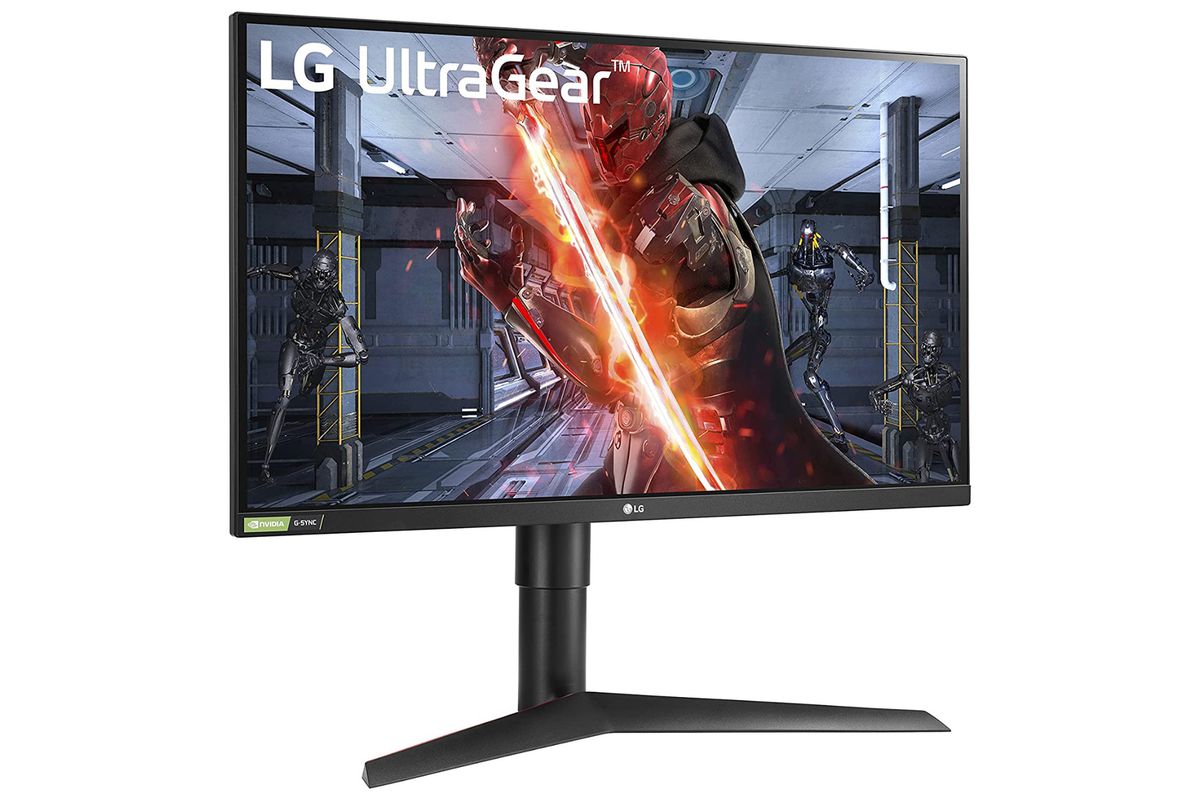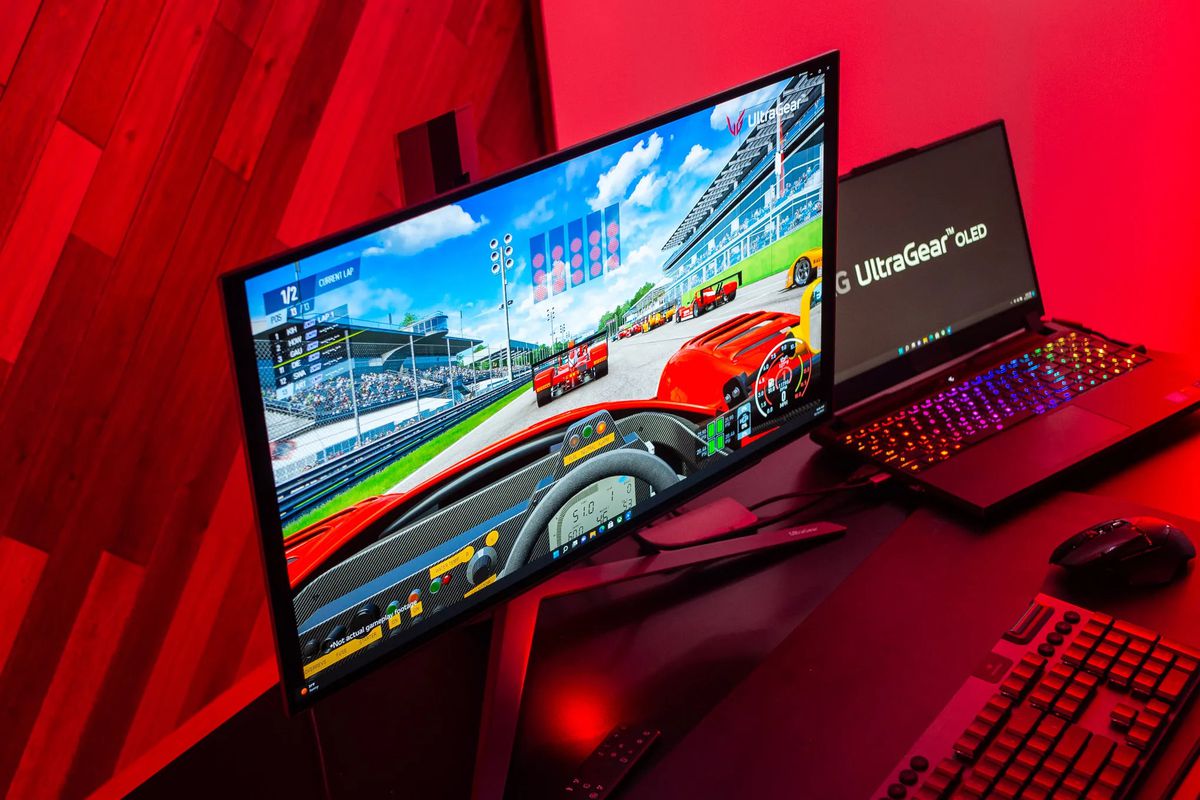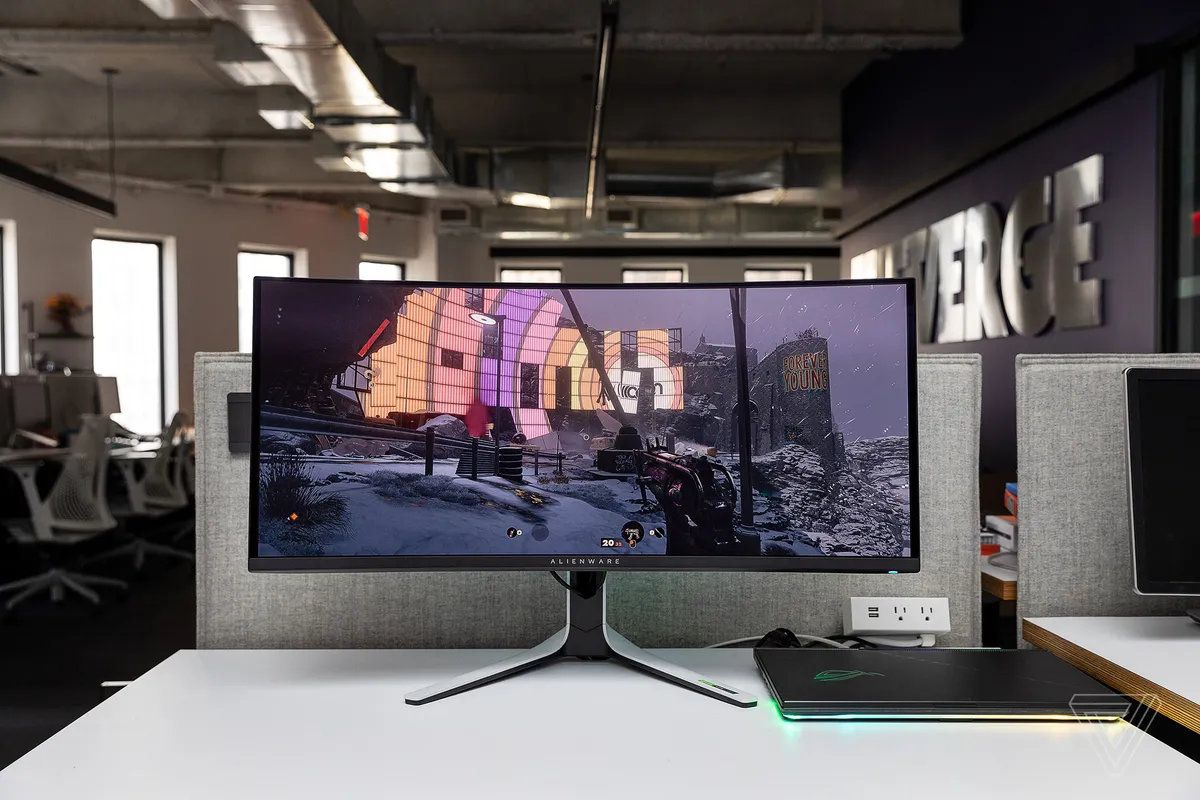Buying a gaming monitor is a big decision. It’s the screen that you’ll be gazing at for hours at a time, over the course of (hopefully) many years of happy ownership. You owe it to yourself to get it right. It’s not just about finding the right size and picture resolution, but ideally making sure it has a design you like, as well as enough ports and features to let you get the most out of your gaming PC, PS5, Xbox Series X, and handheld PCs like the Steam Deck and Asus ROG Ally.
As with most gaming-adjacent components, you can get involved in the process of selecting the perfect monitor, absorbing a host of acronyms and understanding the small yet very important ways some of them differ — or you can let us do the work of sorting out which models currently offer the best performance at the best price. Knowing there are all kinds of gamers out there, our guide includes monitors at varying price ranges and with different resolutions and capabilities.
Best 1080p gaming monitor
Even though many gamers today use consoles and PC hardware that support high resolutions, like 1440p (also referred to as QHD) or 4K, 1080p is still a popular choice for several reasons. For one, rendering games at 1080p is much less taxing on systems. Depending on what consoles or components you intend to connect to your monitor, 1080p might be the best-performing option (and in the case of the Nintendo Switch, 1080p is the maximum resolution supported in docked mode).
Lastly, unless your eyes have been spoiled by the sharpness offered by QHD or 4K, 1080p still looks acceptably sharp on smaller displays (the bigger your 1080p screen, the more pixelated the picture will appear).

There are more affordable options out there, but you can’t go wrong with the 27-inch Asus TUF Gaming VG279QM 1080p gaming monitor, which usually costs about $280. It’s not slacking on a single spec, with its slim bezels and elegant design, fast refresh rate, great picture quality, and variable refresh rate with Nvidia G-Sync compatibility.
While IPS panel tech isn’t known for offering fast refresh rates that can compete with TN LCD panels, this monitor’s Fast IPS tech is a relatively new innovation that allows it to go up to a super-fast 280 Hz, a refresh rate that far exceeds what most monitors and TVs at this price point can achieve. So, games will run smoothly, assuming your PC hardware supports 280 Hz; consoles like the PS5 and Xbox Series X do not (they top out at 120 Hz), but some PCs can via DisplayPort.
This monitor’s rear-facing ports include one DisplayPort 1.2 port, two HDMI 2.0 ports, and a headphone jack. The buttons to control the monitor’s on-screen display are on the back-right side of it. If you’d prefer to remove the included height-adjustable stand, the Asus monitor can be mounted to a VESA monitor arm, or to a wall mount.
Best 1440p gaming monitor
Despite being a significant leap in visual quality over 1080p, prices have come way down on 1440p monitors. Like, they’ve become so affordable that most people should, with the future in mind, consider one of these instead of a 1080p model. Text will be easier to read, images will look cleaner, and of course, games will benefit greatly from the extra sharpness offered at the 1440p resolution. It’s the sweet spot in terms of price and performance.
If you’re deciding between 1440p and 4K, I recommend comparing the resolutions in person if you can. The difference might not be as noticeable as you’re expecting (maybe it will be — that’s totally cool, too). The bigger thing to keep in mind is, just like we mentioned with 1080p monitors, rendering games at 1440p will typically produce smoother visuals than trying to squeeze true 4K (2160p) out of your hardware.
As far as what hardware supports 1440p resolution, both the PS5 and Xbox Series X can — and at a fast 120 Hz refresh rate in games that support it, too. On the PC side, you’ll need a relatively capable set of hardware specs, including (but not limited to) one of AMD or Nvidia’s midrange graphics cards from the last couple of years. Of course, the hardware required to run certain games varies, depending entirely on how graphically demanding they are. For example, playing Cyberpunk 2077 at high settings is much tougher on a machine than Cult of the Lamb is.

LG makes some great 1440p gaming monitors, and does so at a range of prices so that everyone can get in on the action. One of its most affordable yet feature-packed options is its 27-inch 27GL83A-B (I said LG was gifted at making monitors, not naming them — they aren’t alone in that regard), a model that offers just enough of everything to justify its already digestible price. At Amazon, it’s currently $299.99, but it tends to fluctuate by $50 or so.
For that price, it offers a lot of solid specs. Beyond its QHD resolution, it has great viewing angles thanks to its IPS LCD panel. It boasts up to a 144 Hz refresh rate via DisplayPort (with Nvidia G-Sync compatibility and AMD FreeSync adaptive sync support), though consoles like the PS5 and Xbox Series X can run at 1440p with a max refresh rate of 120 Hz in supported games. Your games that top out at 60 frames per second will look great on this monitor, too.
This affordable UltraGear monitor has slim bezels on each of its sides, making it a slick deskmate. On its back, there are a handful of ports, including one DisplayPort 1.4 port, two HDMI 2.0 ports, and a headphone jack. If you want to detach its stand to mount it to a monitor arm, this model supports VESA mounts, so you’re all set there.
Unlike most other monitors that use multiple buttons, LG uses a slightly more user-friendly joystick on its bottom that’s responsible for controlling the on-screen menus. My biggest complaint with this model is that its power cord is on the short end.
If you would like to check out another similarly priced option, check out the $249.99 Acer Nitro XV272U. It’s one of the monitors that I use, and I’m presenting it here in case you prefer how its design looks compared to the LG model above. In terms of specs, its refresh rate can go up to 170 Hz for PCs, but it’s otherwise similar.
For a bigger, more unique option, Gigabyte’s M32Q is a 32-inch QHD model that’s available for $399.99. Aside from being larger, it sports a KVM switch, which allows you to control multiple computers connected to it via video inputs with a single keyboard and mouse. This could be great if you want to use the same monitor for work and play, with your gaming PC connected alongside your work computer. Gigabyte makes a similar 27-inch QHD model that costs $329.99.

One of the best things about shopping for a QHD monitor is that you have a growing batch of OLED options to consider. For those who don’t know, OLED technology delivers the pinnacle of picture quality. It offers unbeatable black presentation (the diodes simply don’t illuminate at all in black scenes, giving off complete darkness where it matters most), as well as contrast that’s so good you’ve got to see it to believe it.
An easy recommendation for people who are willing to spend a lot for top-notch picture quality and visual fidelity is LG’s 27-inch, $896.99 UltraGear OLED gaming monitor. While it’s the same size as our cheaper pick above, it packs in an OLED panel that, in addition to making games and movies look their best, results in a lightweight build compared to other similarly-sized monitors.
The 27-inch UltraGear is technically more capable than many of LG’s OLED TVs, thanks to its faster 240 Hz variable refresh rate and lower response time, the addition of DisplayPort, plus two HDMI 2.1 ports. Fast PCs can take advantage of its full range of refresh rate, while consoles like the PS5 and Xbox Series X will top out at 120 Hz refresh rate in supported games.
If you have an opportunity to try it before you buy it, I strongly suggest doing so. That’s partly so you can witness how great the contrast is in person, but also to check if its resolution and pixel density looks worth the money to you. After all, $1,000 for a monitor is a lot of money. This and competing QHD OLED gaming monitors have a relatively low pixels-per-inch (PPI) count, which sometimes makes text appear somewhat pixelated. Again, try before you buy, if you can. Or, at the very least, make sure you buy from a retailer that has a very good return policy.

Another OLED worthy of your consideration is Alienware’s 34-inch AW3423DW curved gaming monitor, which I reviewed for The Verge. It uses a QD-OLED panel manufactured by Samsung Display, which allows it to shine a little brighter than competing OLED panels currently developed by LG Display. While the difference between the two screen types isn’t night-and-day (they all look spectacular), what could be more revelatory is this monitor’s slight yet noticeable 1800R curvature that puts the screen in more parts of your peripheral vision.
This bigger monitor carries a slightly larger price tag that recently has hovered around $1,099.99 — pricey, but not unreasonable considering it’s 7 inches larger than the LG model mentioned above, and that it’s curved. However, not all the Alienware QD-OLED unique qualities are universally positive for gamers. For instance, it has a widescreen 21:9 aspect ratio, which is supported in some but not all PC games. As a result, you may be stuck playing new releases, or old favorites, with huge vertical black bars surrounding the picture. For consoles like the PlayStation 5 and Xbox Series X, 21:9 aspect ratio isn’t supported at all, so you’ll only take advantage of the center portion of this monitor’s panel real estate. Movies and other content made in the 16:9 aspect ratio will also look this way.
That potential issue aside, the AW3423DW is packed with features and ports. With its single DisplayPort input, it can display up to a 175 Hz refresh rate (with support for Nvidia G-Sync Ultimate), or up to 100 Hz through either of its two HDMI 2.0 ports. It also has multiple USB ports for connecting accessories to your PC.
Alienware makes a slightly less costly version of this monitor, called the AW3423DWF. It sells for $999.99 at Best Buy, sometimes less at Dell, and it knocks the maximum refresh rate down to 165 Hz for DisplayPort (it retains a 100 Hz max refresh rate via HDMI 2.0), and replaces the onboard Nvidia G-Sync Ultimate support with AMD FreeSync Premium Pro. One other difference that may be huge (in a positive way) for some is that, according to PC Gamer’s review, this version has a glossy coating on its screen instead of a matte coating. To some, the matte coating can alter the purity of an OLED’s perfect contrast ratio, to the point that they’d rather accept some glare.
There are seriously so many interesting QHD gaming monitors out there. If you want more OLED options, there’s the $1,599.99 45-inch Corsair Flex, which can be physically bent to be curved or flat — your choice. I took a close look at a non-final version of it at The Verge before it launched in early 2023. For a slightly cheaper alternative that has identical specs, LG’s $1,299.99 45-inch UltraGear OLED has a similar shape, but it’s stuck in curved mode.
Best 4K gaming monitor
We don’t blame you for being interested in a 4K gaming monitor. While 8K looms on the tech landscape’s horizon, 4K shows no sign of fizzling out. It’s still the high-end option of choice for gamers and moviegoers. However, there are some things to know before buying a 4K gaming monitor.
While it’s less of a struggle for the latest gaming consoles and high-end PCs to run games at the demanding 4K resolution, the struggle is still there. Even if your 4K monitor is capable of a 144 Hz refresh rate or higher, you might only have a handful of games that can run well enough to let you enjoy all of the monitor features you’re paying for (that is, unless you turn down some graphics settings).
Also, while they have become cheaper in the past couple of years, 4K monitors are considerably more pricey than 1440p monitors. It’s common for them to cost hundreds of dollars more than a similar-sized (and similarly featured) 1440p gaming display, just because of their higher resolution. If you’re serious about getting a 4K monitor, try to test some out in person before you buy. Sitting closely to your monitor? 4K might be more worth the cost in that scenario than if you’re sitting farther away.
This is the third 27-inch LG gaming monitor that I’ve included on this list — listen, LG makes good displays and solid stands, and I just think that 27 inches is an ideal size for most people. Design-wise, this 4K UltraGear 27GP95R-B doesn’t stand out much from its QHD and FHD counterparts. However, there are some improvements, both inside and outside.
Starting with design, the bezels are very thin, delivering a higher screen-to-body ratio, in case you want a minimalist look. For a little flair, there’s a circular ring of colorful LEDs around its back that can be customized within the monitor’s software.
It has a Nano IPS display, which is an LG-developed panel type that has an increased color gamut compared to standard IPS for more lifelike contrast, according to DisplayNinja. It doesn’t compare with the likes of OLED, but it’s not bad. As such, this could be a fantastic alternative to LG’s 27-inch UltraGear QHD OLED, if that one’s $999.99 price is too steep. This $647 monitor offers a superior 4K resolution for less, and it should still make games and movies look stunning.
We wouldn’t include this monitor if it didn’t have killer specs. It doesn’t disappoint with its 144 Hz refresh rate, plus adaptive sync support for AMD FreeSync Premium Pro and Nvidia G-Sync compatibility. In terms of ports, it features one DisplayPort and two HDMI 2.1 ports, allowing the PS5, Xbox Series X, and some PC GPUs to output 4K resolution at 120 Hz in games that support it.
Another one you may want to consider is Gigabyte’s $649.99 32-inch M32U. Its design isn’t as minimalist as the LG model above (and its IPS panel doesn’t get as bright, nor does it support as wide of a color range), but I’m honestly nitpicking. It might have many of the specs that you’re looking for in your next monitor, and at a price that sits better with your budget.
The M32U similarly features a 144 Hz refresh rate, and support for AMD FreeSync Premium Pro and Nvidia G-Sync compatibility. In terms of ports, you’ll find a single DisplayPort 1.4 port, two HDMI 2.1 ports, and a headphone jack on its back, plus multiple USB ports for connecting accessories to your PC. Uniquely, you can plug a second video source into its USB-C port, like another computer, then hit the monitor’s KVM (keyboard, video, mouse) switch button to assume control of it with all of your connected accessories. It’s pretty cool.
I’m also smitten with the Acer Predator XB283K, a 28-inch 4K gaming monitor that currently costs $549.99 at Amazon. Its ports, panel type, and features are nearly identical to the other options mentioned above.
Best portable gaming monitor
It’s possible to buy small gaming monitors, but you might want something even smaller for your setup, or at least more portable for travel. For that, portable gaming monitors can be easily packed away, and just as easily set up to play some games on. There are a bunch of similar options, and just a couple that stick out as being worth your money.
If you were tempted by the OLED gaming monitors above, there’s good news: a brand called Innocn makes a solid 13.3-inch portable OLED monitor that won’t break the bank. Currently $199.99 at Amazon (sometimes there’s a coupon to save even more), you’ll get stunning picture quality on a small screen that you can plug your console or PC into. It ships with a USB-C to USB-C cable for PCs and other devices (including Steam Deck), plus a Mini HDMI to HDMI cable for consoles. While it tops out at 60 Hz refresh rate and 1080p resolution, it has a fast 1 ms response time, so at least your inputs won’t feel delayed.
I first heard of this brand and monitor thanks to Digital Foundry’s John Linneman, who reviewed it in 2022. Some things worth knowing before you race off to buy either the 13.3-inch or 15.6-inch model is that that they can’t be mounted to a VESA mount (they include a kickstand), and that their brightness is determined by the amount of power they’re getting. They can reach a peak 400 nits when plugged in with their included power adapter, though Linneman notes that they can be powered via USB ports with varying levels of brightness.
Update (Aug. 2): Checked prices and ensured that products are in stock.
- SEO Powered Content & PR Distribution. Get Amplified Today.
- PlatoData.Network Vertical Generative Ai. Empower Yourself. Access Here.
- PlatoAiStream. Web3 Intelligence. Knowledge Amplified. Access Here.
- PlatoESG. Automotive / EVs, Carbon, CleanTech, Energy, Environment, Solar, Waste Management. Access Here.
- BlockOffsets. Modernizing Environmental Offset Ownership. Access Here.
- Source: https://www.polygon.com/what-to-buy/23776092/best-gaming-monitor-4k-1440p-1080p




